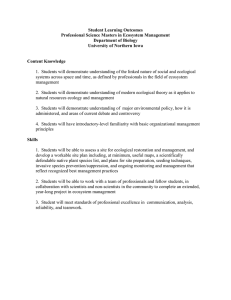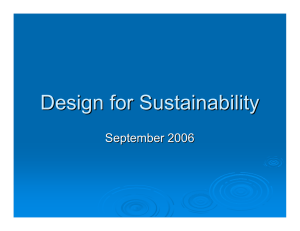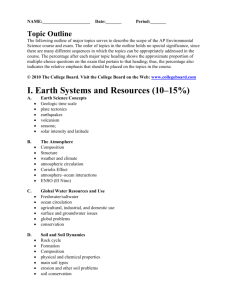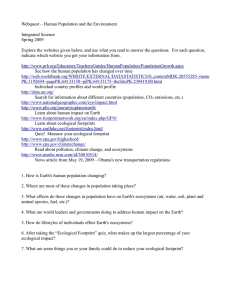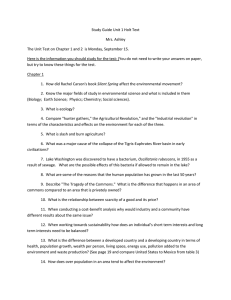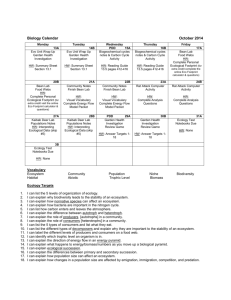Agricultural Sustainability: Opportunities for contributions from computational sciences Laurie Drinkwater Cornell University
advertisement
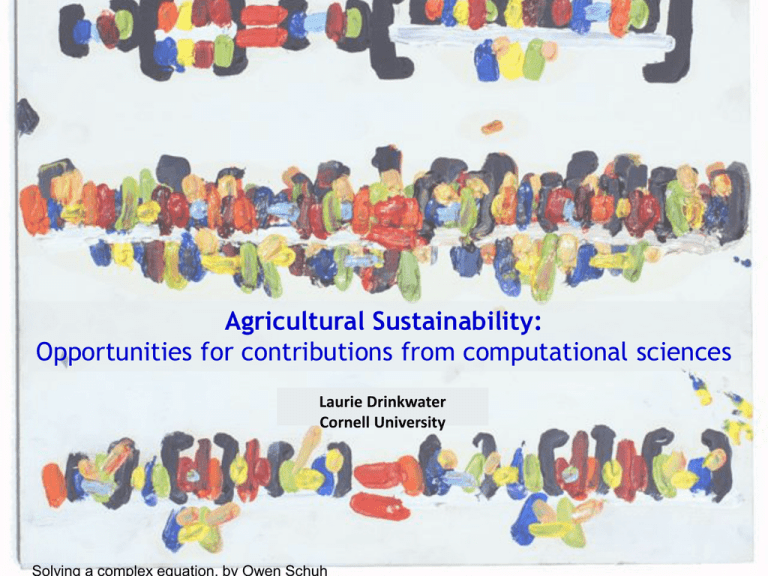
Agricultural Sustainability: Opportunities for contributions from computational sciences Laurie Drinkwater Cornell University Overview of this talk • Context – Global situation in terms of food, hunger and environmental change • Transitioning to sustainable agricultural systems – What are the challenges that must be addressed? – Ideology and values play a role in defining sustainable agriculture – Social-ecological systems: A useful conceptual framework • Potential questions for computational sciences – Three examples Global food situation • Nearly 900 million people -about 13% of the world population -- do not have enough food (FAO) • About 40% of the world population relies on subsistence agricultural systems • Currently, we have sufficient food for our population– political and economic conditions prevent access • Can food production continue to keep pace with population growth? • Humans occupy 75% of the ice-free terrestrial surface and manage 90% of the NPP • Agricultural systems dominate a majority of the most productive biomes Ellis and Ramankutty 2008 Consequences of intensification • Resource consumption by industrial agriculture is enormous and is undermining long term productivity of our agricultural lands. – Fossil fuels, water, soil, land area • Agricultural systems disrupt the integrity of natural ecosystems and contribute to widespread losses of biodiversity. – Movement of nutrients, toxic chemicals and sediments – Extensive land use • Agriculture is a major contributor to global climate change. – 52% and 84% of global anthropogenic CH4 and N2O, significant C02 • Despite progress in food output on a per acre and per capita basis, the quality of life for farm families and rural communities continues to decline. – Reduced income over time, health issues Human activities and environmental consequences are changing rapidly Steffan et al. 2004. Global Change and the Earth System. Transitioning to sustainable agricultural systems http://waterweek.wordpress.com/2007/09/19/ Ecosystem Services The benefits people obtain from ecosystems Millennium Ecosystem Assessment- www.millenniumassessment.org What are our goals for agriculture? • Multifunctional: Food and fiber plus ecosystems services • Provide healthy, nutritional food in sufficient quantities • Production and food systems must be resilient • Quality of life for farm families and vibrant rural communities • Reverse environmental degradation: local to global scales Super techno Techno-eco Super eco http://www.holocene.net/ Agriculture as a social-ecological system • Food production is still largely dependent on ecological processes despite intensification • Social processes govern the design and development of production systems and agricultural technology as well as land use patterns • So far, social processes have not proven to be adept at responding to ecosystem change or mitigating undesirable consequences EU: DPSIR Framework Pressure on the environment Social and economic Driving forces Societal Response State of the environment changes Impacts on human health, [Impacts on other species or undermining Ecosystem Services(?)] What areas could benefit from computer science and mathematics? Three examples… • Ecosystem modeling—Flows of energy and materials • Resource accounting– Ecological footprint and life cycle analysis • Spatial and temporal analysis of existing (massive) data sets Ecosystem modeling Ecosystem process models have five components 1. Forcing functions or external variables-naturally imposed variables that influence the state of the ecosystem 2. State variables-variables that describe the state of the ecosystem 3. Mathematical equations-represent biological, chemical and physical functions and describe the relationship between forcing functions and state variables 4. Parameters-coefficients in the mathematical representation of processes 5. Universal constants-naturally occurring constants Jorgensen and Bendoricchio 2001 The Decomposition-Denitrification Model ecological drivers Climate Soil Vegetation water demand water uptake potential evapotrans. evap. trans. vertical water flow CO2 O2 diffusion soil Eh profile O2 use grain NH4+ NO2- N2 O N2 Denitrification nitrite denitrifier N2 O denitrifier resistant labile resistant stems humads DOC labile resistant Plant growth passive humus Temperature nitrate denitrifier labile root respiration effect of temperature and moisture on decomposition soil environmental factors very labile microbes N-uptake roots Soil climate NO N-demand water stress soil temp profile soil moist profile daily growth litter annual average temp. LAI-regulated albedo Human activity DOC Moisture pH DOC NH4+ nitrifiers NO3NO3- N2 O Nitrification NH3 NO NH3 Eh clayNH4+ Decomposition Substrates: NH4+, NO3-, DOC soil Eh CH4 production aerenchyma CH4 oxidation DOC Fermentation CH4 transport CH4 Modeling flows of energy and materials Water drainage from watersheds planted with corn and soybean on tile-drained Mollisols in Illinois 180 Observations DAYCENT DNDC82a DNDC82h Drainage (mm month-1) 160 140 120 100 80 60 40 20 0 97 98 99 00 01 02 Year Graph courtesy of Christina Tonitto 03 04 05 06 07 Comparison of six widely used process models: Daily N2+N2O flux predictions across models 1 2 3 4 5 DRAINMOD N-II SWAT DAYCENT DNDC82h DNDC82a EPIC -1 -1 Denitrification (kg N ha d ) 0.6 0.5 0.4 0.3 0.2 0.1 0.0 Jan Feb Mar Apr May Jun Jul Aug Sep Oct Nov Dec 2002 David et al. 2009 Precipitation (cm) 0 • Models had different predictions for water flux, soil moisture status • They also had very different seasonal predictions of N gas flux • With limited field data we can not distinguish which model perform best • Options for resolving this: massive data collection and increased complexity of models • Can we develop simple models to serve need of policymakers? • Can we combine spatial and process modeling? The Ecological Footprint • Developed by Wackernagel and Rees, 1996: Our Ecological Footprint: Reducing Human Impact on the Earth • Attempts to answer a single question: How much of the planet’s capacity do we use compared to how much is available? • Compares the area we demand to how much area is available • Currently, it provides the only available comprehensive answer to this research question. • Based on real data: consumption and production • How does this approach differ from carrying capacity? http://www.footprintnetwork.org/en/index.php/GFN/ Global ecological footprint by component, 1961-2005 http://www.footprintnetwork.org Living Planet Report 2008 Ecological Footprint per person, by country for 2005 http://www.footprintnetwork.org Living Planet Report 2008 Ecological creditor and debtor countries, 2005 Ecological Footprint summary • Provides insights on sustainability of natural capital use at large scales: regions, nations and global • Example: Because the calculations are based on actual consumption rates that reflect current technology, we can conclude that technology has not kept pace with increased consumption • Limitations in terms of env. Impact of toxins, materials that do not decompose, and resource depletion outside the biosphere • Strong ecological basis: datasets and calculation methods have improved since 1996 • Focus on natural capital, efficiency of providing human needs • Does not assess social indicators of sustainability • Application to farm-scale production has yet to be clearly demonstrated but has the potential to be very useful in combination with other approaches Life cycle assessment • Developed in the 1960’s, “industrial ecology” • A “cradle-to-grave” approach for assessing industrial systems. • Begins with the gathering of raw materials from the earth to create the product and ends at the point when all materials are returned to the earth. • Quantifies environmental releases to air, water, and land in relation to each life cycle stage and/or major contributing process in the course of the product’s life-span Life cycle stages reflect the industrial origins LCA of three contrasting pig production systems Van der Werf et al. 2003 LCA summary • Focus is on assessing natural capital: source-sink and environmental impacts • Integrates known environmental impacts • Interpretation of trade-off across env. Impacts depends on subjective decision-making of the evaluators • Sound ecological basis but estimating emissions in agricultural systems presents a formidable challenge (open versus point emissions) • Units for reporting resource use and emissions determine performance of contrasting systems Spatial and temporal analysis of human dominated landscapes Intensification of the landscape continues to increase: loss of winter annuals 35000 Crop Area (1000 ha) 30000 Corn 25000 Wheat 20000 15000 Hay 10000 Soybean Oat 5000 0 1940 David et al, in prep. 1950 1960 1970 1980 1990 2000 2010 Crop distribution in Illinois, 2004 Corn Soybean Pasture There is a vast amount of biophysical and social data available. USDA and Census Bureau, NRCS Understand spatial patterns and temporal dynamics of agricultural landscapes Average N loss at a county level in the Mississippi River Basin Leak 2 0 - 26 27 - 67 68 - 116 117 - 171 172 - 259 Mark David et al., in prep Conservation payments are lowest in the high yielding regions Fraction Conservation Payments to Total Payments 0.0 - 9.5 9.6 - 19.7 19.8 - 32.5 32.6 - 48.0 48.1 - 100.0 Conclusions • Tremendous potential for computational sciences to contribute • Vast amounts of information are not being exploited to their full potential • The pace of change presents a significant challenge • Quantitative analysis of systemic trends can help society adapt and respond appropriately to environmental change
